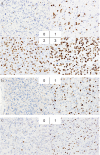Molecular Aberrations Associated with Seizure Control in Diffuse Astrocytic and Oligodendroglial Tumors
- PMID: 32009124
- PMCID: PMC7073702
- DOI: 10.2176/nmc.oa.2019-0218
Molecular Aberrations Associated with Seizure Control in Diffuse Astrocytic and Oligodendroglial Tumors
Abstract
Diffuse astrocytic and oligodendroglial tumors are frequently associated with symptomatic epilepsy, and predictive seizure control is important for the improvement of patient quality of life. To elucidate the factors related to drug resistance of brain tumor-associated epilepsy from a pathological perspective. From January 2012 to October 2017, 36 patients diagnosed with diffuse astrocytic or oligodendroglial tumors were included. Assessment for seizure control was performed according to the Engel classification of seizures. Patient clinical, radiological, and pathological data were stratified based on the following 16 variables: age, sex, location of tumor, existence of the preoperative seizure, extent of resection, administration of temozolomide, radiation therapy, recurrence, Karnofsky performance scale, isocitrate dehydrogenase 1, 1p/19q co-deletion, Olig2, platelet-derived growth factor receptor alpha, p53, ATRX, and Ki67. These factors were compared between the well-controlled group and drug-resistant seizure group. Twenty-seven patients experienced seizures; of these, 14 cases were well-controlled, and 13 cases were drug-resistant. Neither clinical nor radiological characteristics were significantly different between these two groups, though p53 immunodetection levels were significantly higher, and the frequency of 1p/19q co-deletion was significantly lower in the group with drug-resistant seizures than in the well-controlled group. In the multivariate analysis, only one item was selected according to stepwise methods, and a significant difference was observed for p53 (OR, 21.600; 95% CI, 2.135-218.579; P = 0.009). Upregulation of p53 may be a molecular mechanism underlying drug resistant epilepsy associated with diffuse astrocytic and oligodendroglial tumors.
Keywords: diffuse astrocytoma; epilepsy; glioma; oligodendroglioma.
Conflict of interest statement
The authors declare that they have no conflicts of interest.
Figures


Similar articles
-
Not all 1p/19q non-codeleted oligodendroglial tumors are astrocytic.Oncotarget. 2016 Oct 4;7(40):64615-64630. doi: 10.18632/oncotarget.11378. Oncotarget. 2016. PMID: 27556304 Free PMC article.
-
Allelic losses at 1p36 and 19q13 in gliomas: correlation with histologic classification, definition of a 150-kb minimal deleted region on 1p36, and evaluation of CAMTA1 as a candidate tumor suppressor gene.Clin Cancer Res. 2005 Feb 1;11(3):1119-28. Clin Cancer Res. 2005. PMID: 15709179
-
ATRX immunohistochemistry can help refine 'not elsewhere classified' categorisation for grade II/III gliomas.Br J Neurosurg. 2019 Oct;33(5):536-540. doi: 10.1080/02688697.2019.1600657. Epub 2019 Apr 24. Br J Neurosurg. 2019. PMID: 31018710
-
Low-grade developmental and epilepsy associated brain tumors: a critical update 2020.Acta Neuropathol Commun. 2020 Mar 9;8(1):27. doi: 10.1186/s40478-020-00904-x. Acta Neuropathol Commun. 2020. PMID: 32151273 Free PMC article. Review.
-
Integrated diagnostics of diffuse astrocytic and oligodendroglial tumors.Pathologe. 2019 Jun;40(Suppl 1):9-17. doi: 10.1007/s00292-019-0581-8. Pathologe. 2019. PMID: 31025086 Review. English.
Cited by
-
A Nationwide Questionnaire Survey on Awake Craniotomy in Japan.Neurol Med Chir (Tokyo). 2022 Jun 15;62(6):278-285. doi: 10.2176/jns-nmc.2021-0290. Epub 2022 Mar 29. Neurol Med Chir (Tokyo). 2022. PMID: 35354712 Free PMC article.
-
Preoperative Prediction of Communication Difficulties during Awake Craniotomy in Glioma Patients: A Retrospective Evaluation of 136 Cases at a Single Institution.Neurol Med Chir (Tokyo). 2021 Jan 15;61(1):21-32. doi: 10.2176/nmc.oa.2020-0232. Epub 2020 Nov 19. Neurol Med Chir (Tokyo). 2021. PMID: 33208581 Free PMC article.
-
Efficacy of antiepileptic drugs in glioma patients with epilepsy: a systematic review.Neurooncol Pract. 2021 May 28;8(5):501-517. doi: 10.1093/nop/npab030. eCollection 2021 Oct. Neurooncol Pract. 2021. PMID: 34589231 Free PMC article. Review.
-
Correlation of Clinicopathological Factors with Brain Tumor-Related Epilepsy in Glioma.Dis Markers. 2022 Sep 30;2022:4918294. doi: 10.1155/2022/4918294. eCollection 2022. Dis Markers. 2022. Retraction in: Dis Markers. 2023 Jun 21;2023:9823853. doi: 10.1155/2023/9823853. PMID: 36246555 Free PMC article. Retracted.
-
Effect of Early Surgical Intervention for Brain Tumors Associated with Epilepsy on the Improvement in Memory Performance.Neurol Med Chir (Tokyo). 2022 Jun 15;62(6):286-293. doi: 10.2176/jns-nmc.2021-0175. Epub 2022 Apr 12. Neurol Med Chir (Tokyo). 2022. PMID: 35418529 Free PMC article.
References
-
- Danfors T, Ribom D, Berntsson SG, Smits A: Epileptic seizures and survival in early disease of grade 2 gliomas. Eur J Neurol 16: 823–831, 2009 - PubMed
-
- Rudà R, Trevisan E, Soffietti R: Epilepsy and brain tumors. Curr Opin Oncol 22: 611–620, 2010 - PubMed
-
- Mulligan L, Ryan E, O’Brien M, et al. : Genetic features of oligodendrogliomas and presence of seizures. The relationship of seizures and genetics in LGOs. Clin Neuropathol 33: 292–298, 2014 - PubMed
MeSH terms
LinkOut - more resources
Full Text Sources
Medical
Research Materials
Miscellaneous

